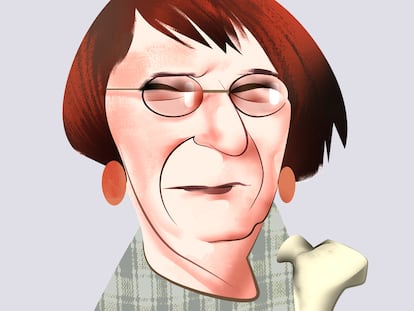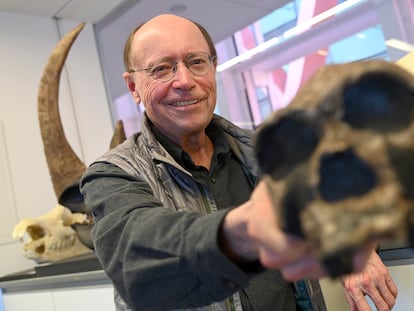The legacy of Lucy, the ‘Australopithecus’ that changed our idea of human evolution 50 years ago
The fossil remains of the unique hominid were found in Ethiopia in 1974, traveled around the world, were the subject of controversy and became an icon of science. Even today they continue to provide answers to where we come from
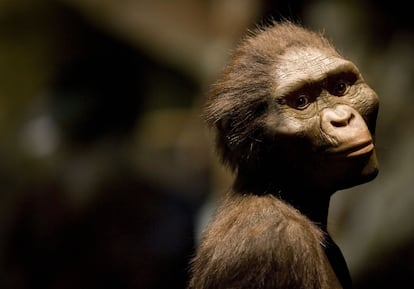
On the evening of November 24, 1974, in a camp in northeastern Ethiopia, American anthropologist Donald Johanson and his assistant Tom Gray were drinking cold beer around the fire while a goat was cooking on embers. They were celebrating, along with a handful of colleagues: that very morning they had found the fossilized bones of what appeared to be a hominid never before described by science. They sang and danced to the music of the Beatles. Their song Lucy in the Sky With Diamonds came on and someone ventured: “Why don’t we call her Lucy?” The name stuck, and Lucy became the most famous fossil in history. Her discovery led to thousands of questions. The two main ones were: what species did she belong to? And was humanity beholding its closest primate relative?
One of those tasked with clearing up these questions was Tim White, a paleoanthropologist also from the United States. He studied the fossils, whose discovery took place 50 years ago this month. He is now 74 and lives in Burgos, Spain, as a scientist affiliated with the National Center for Research on Human Evolution, far from the spotlight that focused on Lucy when she was presented to the world. The 47 fragments found dated back 3.2 million years and formed a fossil so complete that it allowed people to imagine for the first time what this remote ancestor was like.
Thus, Lucy forever changed the field of paleoanthropology: “These fossils represent our evolution. Lucy’s lineage led to the genus Homo, the genus of our species,” White explains. That skeleton helped put together the pieces of an evolutionary puzzle that, until then, had been in disarray, full of loose ends. After several years of study, in 1978 Johanson and White no longer had doubts, but certainties: they announced that Lucy and other fossils they found later all came from a single, previously unknown species of hominid. They called it Australopithecus afarensis.
Like many other paleoanthropologists around the world, Juan Luis Arsuaga, scientific director of the Museum of Human Evolution (Burgos), has spent a good part of his career studying what came from Lucy. “She is what was missing to link humans with monkeys, an intermediate form of life. The missing link,” he says. He quickly corrects himself: “I wouldn’t use the term ‘missing link’ in a class because it’s an outdated idea, but it’s good for explaining what Lucy meant for science, it’s nice.”
“The bones are the obsession, but they are the least important thing. What is truly important is the data they provide,” says Arsuaga. And the information that Lucy provided was a lot: she was four feet tall, she died at 11 or 12 years of age (the key to determining this was a worn-out wisdom tooth), her posture and locomotion were bipedal, she had a small brain, and a pelvis similar to that of a human.
For White, the passage of time has helped put the find he helped interpret into perspective: “The notion that Lucy was revolutionary is simply false,” he says. His argument is that several Australopithecus fossils had already been found in South Africa by 1940. These included a specimen known as STS 14, whose anatomy is almost indistinguishable in size and features from Lucy’s. Yet the skeleton of the famous Australopithecus was for years the most complete ever found.
On paper, these are two different species: Lucy is an afarensis, while STS 14 is an africanus, though White believes the variations between them are subtle. “It is said that Lucy’s remains are the first of an upright-walking primate and that they disproved Darwin’s theory on how human evolution developed. He had an explanation of how bipedalism, tool use, brain expansion, and reduced canines evolved together. Australopithecus refuted that hypothesis,” the scientist points out.
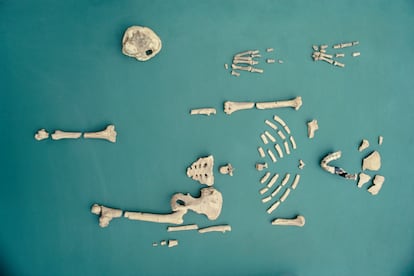
White is referring to Charles Darwin’s proposal that there was an almost linear leap from primates to humans, with the three defining characteristics of the Homo genus—bipedalism, tool-making, and large brains—evolving together. But this wasn’t the case. Lucy was one of the fossils that helped demonstrate that evolution was much more complex, diversifying into a denser and more robust family tree that includes multiple species which inhabited Tanzania, Chad, Kenya, and Ethiopia four million years ago. Lucy’s fossils provided enough evidence to show that our ancestors walked on two feet long before their brains grew larger. Were they more human or more ape? That depends on who you ask.
According to José María Bermúdez de Castro, a paleoanthropologist and researcher on the Atapuerca project, Lucy’s merit is that she managed to articulate all the findings that had been building in Africa since the 1920s. “Everything was poorly connected and it was not known how to unite modern humans with the different forms of hominids similar to Lucy that had been found until then.” White agrees, but also distances himself: “Lucy added an important piece to that puzzle. Even so, we cannot put her on a pedestal because we would ignore the ultimate goal of paleoanthropology, which is to understand the biology of our ancestors. That cannot be done by elevating a single individual.”
A symbol of science and Ethiopia
No one can deny that Lucy is an icon, and not just in science. There is an image imprinted in Arsuaga’s brain that sums up the Australopithecus’ massive popularity and the pride it represents for Ethiopians, even 50 years after its discovery. Last Easter, the scientist accompanied a group of Spanish hikers to the national parks of Africa: the gigantic plane that took them from Ethiopia to Tanzania was called Lucy.
This is just one example of the scientific marketing that exists around the remains of this hominid. Starting with the fortunate choice of her name. “Lucy is the perfect example of good public relations management,” says White. He adds that Johanson, her discoverer, was the perfect promoter. “He had the support of National Geographic and used [that scientific society] to his advantage. He also had the support of the major American television networks like ABC, NBC and CBS, which brought a full-color Lucy to every corner of the United States.” Johanson then wrote several books. “Books that in some way had already been written in the 1940s by South Africans who had been studying human evolution, but who did not have the same platform,” says the researcher.
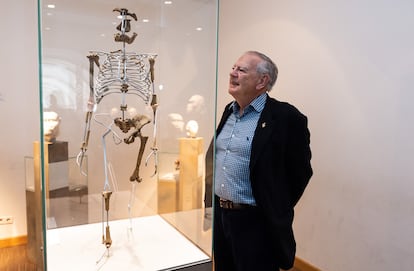
Rebeca García, a member of the Human Evolution Laboratory at the University of Burgos and a specialist in postcranial skeleton, points out that, in addition, all the recreations that have been made of Lucy “are very endearing,” making it easy for the general public to empathize and relate to her. Almost like a pop culture figure, the remains of the Australopithecus — which now rest in a safe at the National Museum of Ethiopia — transcend generations.
Science never tires of exploring the mystery of Lucy. Even today, articles and theses are still being written about her. García goes into detail: “The latest research being carried out explores what gestation and birth were like in this species; what their newborns were like and their model of rearing. The remains continue to provide much to talk about.”
Some questions, however, are still buried in sediment and no one has yet asked them. “Science is advancing so much that we cannot even imagine what answers Lucy will bring in the future, but she will continue to be fundamental in the study of human evolution, probably for another 50 years,” says García.
Sign up for our weekly newsletter to get more English-language news coverage from EL PAÍS USA Edition
Tu suscripción se está usando en otro dispositivo
¿Quieres añadir otro usuario a tu suscripción?
Si continúas leyendo en este dispositivo, no se podrá leer en el otro.
FlechaTu suscripción se está usando en otro dispositivo y solo puedes acceder a EL PAÍS desde un dispositivo a la vez.
Si quieres compartir tu cuenta, cambia tu suscripción a la modalidad Premium, así podrás añadir otro usuario. Cada uno accederá con su propia cuenta de email, lo que os permitirá personalizar vuestra experiencia en EL PAÍS.
¿Tienes una suscripción de empresa? Accede aquí para contratar más cuentas.
En el caso de no saber quién está usando tu cuenta, te recomendamos cambiar tu contraseña aquí.
Si decides continuar compartiendo tu cuenta, este mensaje se mostrará en tu dispositivo y en el de la otra persona que está usando tu cuenta de forma indefinida, afectando a tu experiencia de lectura. Puedes consultar aquí los términos y condiciones de la suscripción digital.
More information
Archived In
Últimas noticias
Most viewed
- Pablo Escobar’s hippos: A serious environmental problem, 40 years on
- Reinhard Genzel, Nobel laureate in physics: ‘One-minute videos will never give you the truth’
- Why we lost the habit of sleeping in two segments and how that changed our sense of time
- Charles Dubouloz, mountaineering star, retires at 36 with a farewell tour inspired by Walter Bonatti
- The Florida Keys tourist paradise is besieged by immigration agents: ‘We’ve never seen anything like this’

